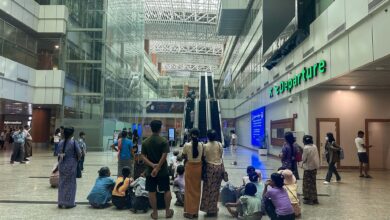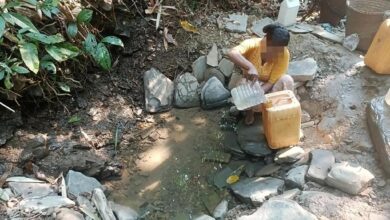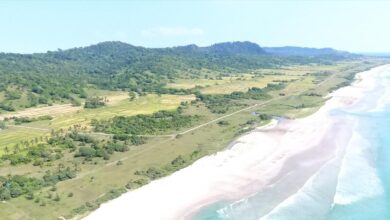
At a Yangon fish farm one recent morning, Myanmar Now watched as chicken faeces fell from coops suspended above a pond, down into the water, where a scrum of fish formed to snack on it.
The practice, known as integrated animal-fish farming, pairs fish ponds with other livestock – often chicken, but also pigs and geese – grown in close proximity, with the animal waste used to generate fish feed.
Advocates say the method is economical, and that the animal waste acts only to fertilize the phytoplankton in the ponds that fish feed on. They deny the fish eat the animal waste itself.
But Myanmar Now saw fish feasting on such waste at six separate integrated farms in Yangon’s Hlegu and Mingalardon township during trips in January and February.
Public health experts say the practice encourages the spread of harmful bacteria and that toxic metals found in chicken feed accumulate in fish, from both the chicken waste and from chicken feed that spills into ponds from the coops above.
Trade groups also worry about the practice. It’s banned in much of the developed world, and they say Myanmar’s continued use of integrated farms makes Myanmar a pariah in international seafood markets.

Economics
The MFF permits up to 1,000 chickens to be raised per acre of fish farm. This chicken can be brought in batches to market six times before the first fish can be sold. Integrated farming, they say, helps sustain the longer and more costly fish production before it can generate revenue.
For farmers working on a shoestring, it also beats buying more expensive fish feed from Chinese or Thai manufacturers.
They argue that ending the practice would make chicken, fish and eggs unaffordable for much of the public.
“Who takes responsibility for the rise in price that would follow abolishing this practice,” asked Myanmar Livestock Federation (MLF) Yangon branch vice chairman Myint Aung.
Yangon’s 250 integrated farms employ more than 6,000 people. If the system is quickly ended it will weaken public food security and hurt the livelihoods of those employees, plus many thousands more that depend on the industry, he said.
Fish exporters, on the other hand, say continuing the practice hurts the national economy more.
As global standards for food safety rise and consumers grow more conscious of how their food is raised, exporters fear that allowing it to continue will hurt Myanmar’s brand as a seafood supplier for world markets.
In fiscal year 2017-18, Myanmar exported 560,000 tons of fisheries products, earning $700m, according to figures published by the state-owned newspaper the Global New Light of Myanmar.
The following year that revenue was up to $732m, according to the ministry of commerce.
Myanmar is the world’s largest exporter of rohu, a type of carp often raised on integrated farms in Myanmar.

Catfish, catla, karfu and pomfret are also often produced on integrated farms, according to the MLF.
Many importers will only buy fish grown on exclusive fish farms, said Win Kyaing, Myanmar Fisheries Federation (MFF) general secretary.
MFF representatives urged vice president Myint Swe to ban the practice at a chamber of commerce meeting in Yangon last October.
Saudi Arabia and the EU – where food safety requirements are among the strictest – ban imports of fish raised on integrated farms. In 1997, both countries stopped buying fish from Myanmar after lab tests showed the fish they were importing had been raised that way.
Both have since resumed importing from Myanmar in the last few years, but only from exclusive fish farms.
According to MLF estimates, about 2,000 such farms were operating in Myanmar in 2019 – mostly in Yangon, Ayeyarwaddy, Bago and Mandalay regions – producing about 1.3m pounds of fish a day, or just over half of all fish sold in Myanmar.

Unsafe at any price?
Whatever market it reaches, public health experts argue that fish from integrated farms is harmful to consumers’ health.
They say it increases the risk of spreading salmonella and other bacterial diseases.
Salmonella, a major cause of food poisoning, leads to diarrhoea, severe stomach ache, vomiting, fever and, in some cases, death.
“If conditions worsen, this intestinal bacteria can also reach the blood, and a small percent of cases can become life-threatening,” Dr Win Maw Tun, director of medical research for the ministry of health and sports’ Yangon branch, told Myanmar Now.
He warned that salmonella can also spread to fruits and vegetables if contaminated chicken manure is used as fertilizer.
But it’s not just bacteria. A 2011 study in the Journal of Applied Sciences found that heavy metals like arsenic, copper, zinc, lead and mercury accumulate at dangerous levels in fish raised on integrated farms.
The metals are present in chicken feed. The feed often falls directly into the pond, where fish eat it, and it is excreted in the chicken faeces that Myanmar Now saw fish feeding on.

Consuming high levels of these metals can cause brain and central nervous system disorders and kidney and liver damage in humans, according to the study.
While trade representatives say Myanmar’s exports come exclusively from fish farms that do not use the integrated approach, on supermarket shelves throughout the country, fish is not differentiated by how it’s raised.
Myanmar Fisheries Products Processors and Exporters Association general secretary Myo Nyunt called this wrong.
“Exporting clean food for foreign markets and feeding local people fish raised on chicken poop is inappropriate,” he told Myanmar Now.
Farmers disagree
Fish farmers deny claims of adverse health effects.
They also petitioned the vice president opposing the ban in a December 2019 letter.
The government has not responded to either party.
Despite what Myanmar Now saw in January and February, Myint Aung insists the fish are not eating manure.
“Fish don’t eat chicken droppings like people say. They eat the phytoplankton that it grows,” he told Myanmar Now. “If we don’t raise chicken on top of the fish ponds, we’d still need chicken manure and cow dung to fertilize the ponds.”
Still, they say, the concerns are overblown.

MLF vice chairman Dr Kyaw Htin said not a single case of fish raised this way causing harm to humans has been documented.
“Look at the FAO (UN Food and Agriculture Organization) website. There has not been a single case of someone getting sick from this,” he said.
In their December 2019 letter to Myint Swe, the MLF said the practice is necessary to make chicken and eggs affordable.
Over 2.7 million chickens are raised for meat and 2.9 million for eggs on integrated farms in Myanmar every year.
Worth higher prices?
Hla Win, former director of the MFF Yangon, said the practice must be abolished.
“From a health perspective, this fish is not safe to eat,” he said.
But, he cautioned, it must be abolished slowly and with care for the workers and business owners who currently depend on it.
Though farmers complain that without the practice it would take too long to profitably bring their fish to market, Kyaw Htin says improved fish feed is increasingly allowing them to speed up the process while also improving the quality and weight of the fish.
Still, he too cautions against abolishing the system too quickly.
“Like owners have said, the practise can’t be stopped abruptly. That would destroy every one of these businesses and weaken food security,” he told Myanmar Now.

“I proposed to the vice president that the system be changed gradually, but we also need to do more research,” he said. “You can’t argue without data.”
The fisheries department, which operates under the agriculture ministry, began monitoring the quality of fish produced at integrated farms just this past October at their ISO-accredited lab, according to deputy director Myint Zin Htoo.
No test results have so far been released, he told Myanmar Now.
As things stand, domestic consumers are left with little choice, unable to know how the fish they buy is raised.
When Myanmar Now spoke with ten random Yangonites at markets in Pabedan township recently, none knew how the fish they bought was raised, nor if fish from integrated farms is safe to eat.
At least one said they’d refuse to eat fish they knew were raised on chicken feed and faeces.
But they also all said they did not want to see the price of chicken or fish rise.
Editing by Danny Fenster



